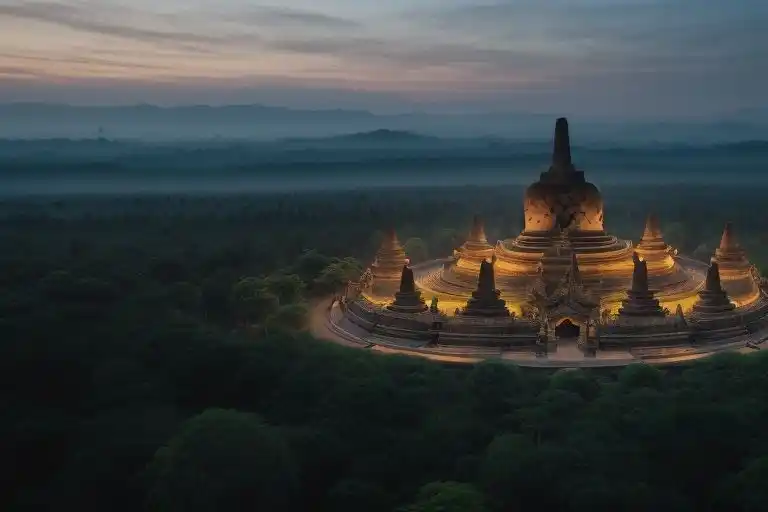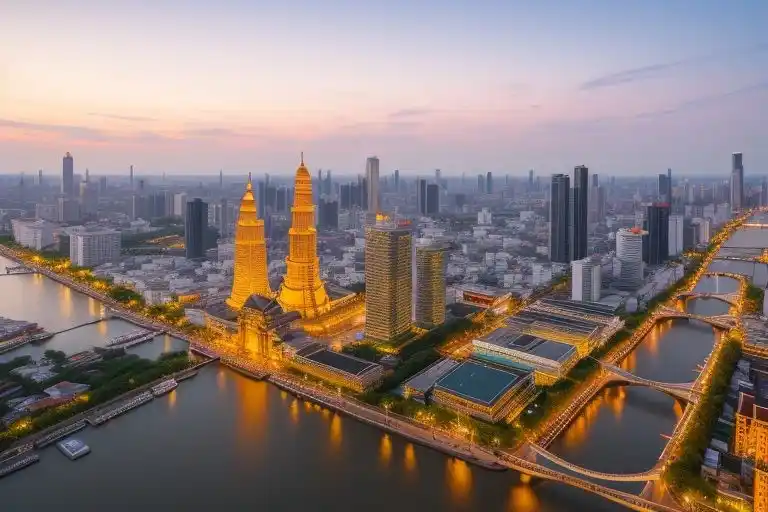
Borobudur, Indonesia: A Massive Buddhist Temple Complex and UNESCO World Heritage Site
Nestled in the heart of Central Java, Indonesia, lies one of the most magnificent and ancient architectural wonders of the world: Borobudur. This colossal Buddhist temple complex, recognized as a UNESCO World Heritage Site, stands as a testament to the rich cultural and religious heritage of the region. Spanning over 2,500 square meters, Borobudur is not just a temple; it is a repository of history, art, and spirituality, featuring over 2,600 relief panels and 504 Buddha statues. In this article, we will delve into the history, architecture, and significance of Borobudur, exploring why it continues to captivate visitors from around the globe.
The History of Borobudur
Borobudur’s origins date back to the 8th and 9th centuries, during the Sailendra Dynasty. This period marked a significant era of Buddhist and Hindu influence in Java, with the construction of numerous temples and monuments. The exact purpose and the details of the temple’s construction are still subjects of historical debate, but it is widely believed that Borobudur was built as a place of worship and a center for Buddhist learning.
For centuries, Borobudur lay hidden under layers of volcanic ash and jungle growth. It was rediscovered in the early 19th century during the British administration of Java, when Sir Thomas Stamford Raffles, the then-governor, ordered a clearing of the site. The temple’s condition was dire, and it required extensive restoration work. The first major restoration project began in the early 20th century under Dutch colonial rule and was completed in the 1980s. Today, Borobudur stands as a well-preserved and meticulously maintained site, attracting millions of visitors each year.
“Borobudur is a unique and precious monument, a testimony to the exceptional skills of the ancient Javanese artisans and the deep spiritual significance it holds for Buddhism.” – UNESCO
The Architecture of Borobudur
Borobudur is a marvel of architectural ingenuity and artistic expression. The temple is built in the form of a stepped pyramid, consisting of nine stacked platforms—six square and three circular—topped by a central dome. The design is inspired by the Mandala concept, a symbolic representation of the universe in Buddhist philosophy.
Materials and Construction
The temple is constructed from over 2 million stone blocks, each carefully carved and placed to form intricate reliefs and statues. The stone used is andesite, a volcanic rock found abundantly in the region. The construction process involved a sophisticated system of interlocking stones, which allowed the temple to withstand the test of time and natural disasters like earthquakes and volcanic eruptions.
Relief Panels
One of the most striking features of Borobudur is its vast collection of relief panels, which cover the walls and balustrades of the temple. These panels depict scenes from Buddhist scriptures and the life of Buddha, as well as everyday life in ancient Java. The reliefs are divided into three main categories:
- Kamadhatu (the world of desire): Depicts the lower realms and the human world, including scenes of everyday life, struggles, and desires.
- Rupadhatu (the world of form): Features images of the life of Buddha, his teachings, and the path to enlightenment.
- Arupadhatu (the world of formlessness): Consists of the uppermost circular platforms, where the focus shifts to more abstract and spiritual themes.
Buddha Statues
Another remarkable aspect of Borobudur is its 504 Buddha statues. These statues are scattered throughout the temple, with each one representing a different aspect of Buddha’s teachings and life. The statues vary in size and style, with some seated in meditation, others in teaching poses, and still others in protective stances. The central dome, known as the Stupa of the Universe, is adorned with 72 perforated stupas, each containing a statue of Buddha.
The Significance of Borobudur
Borobudur holds profound spiritual and cultural significance for both locals and international visitors. It is a place of pilgrimage for Buddhists and a site of immense historical importance for scholars and researchers.
Spiritual Significance
For Buddhists, Borobudur is a sacred site that embodies the journey to enlightenment. The temple’s design is meant to guide visitors through the stages of spiritual development, from the base to the summit. Each platform represents a different level of understanding and awareness, culminating in the central dome, which symbolizes the attainment of Nirvana.
Cultural Significance
Borobudur also serves as a window into the cultural and artistic achievements of ancient Java. The relief panels provide valuable insights into the daily life, beliefs, and practices of the people who built and worshipped at the temple. The intricate carvings and statues are a testament to the advanced craftsmanship and artistic sensibilities of the time.
Educational Value
For researchers and historians, Borobudur is a treasure trove of information. The temple’s architecture, reliefs, and statues offer a wealth of data about the religious, social, and political life of the Sailendra Dynasty. Additionally, the temple’s restoration and conservation efforts have provided valuable lessons in heritage management and preservation.
Tourism and Economic Impact
Borobudur’s significance extends beyond the spiritual and cultural realms. As one of Indonesia’s most popular tourist attractions, it plays a crucial role in the country’s economy. The influx of visitors supports local businesses, creates jobs, and promotes cultural exchange. However, the site’s popularity also poses challenges in terms of managing crowds and preserving the temple’s delicate structures.
Visiting Borobudur
Planning a visit to Borobudur is a rewarding experience, offering a unique blend of history, spirituality, and natural beauty. Here are some tips and important information for those who wish to explore this ancient wonder:
Best Time to Visit
- Avoid Peak Seasons: The best time to visit is during the shoulder seasons (April to May and September to October), when the crowds are smaller and the weather is more pleasant.
- Early Morning: Arrive early in the morning to avoid the heat and to have a more serene and peaceful experience. The sunrise over Borobudur is particularly stunning.
What to Wear
- Comfortable Clothing: Wear comfortable, breathable clothing and sturdy walking shoes. The temple involves a lot of walking and climbing.
- Respectful Attire: Dress modestly, covering your shoulders and knees, as a sign of respect for the religious nature of the site.
Guided Tours
- Hire a Guide: Consider hiring a knowledgeable guide to provide deeper insights into the history and significance of the temple. Guides are available at the entrance or can be arranged in advance.
- Audio Guides: If you prefer a self-paced tour, audio guides are also available and can enhance your understanding of the site.
Photography
- Permit: A permit is required for professional photography, but casual photography is allowed. Respect any restrictions on flash photography to preserve the delicate reliefs.
- Best Angles: The temple offers numerous photogenic spots, including the central dome, the relief panels, and the surrounding landscape. Early morning and late afternoon provide the best lighting conditions.
Nearby Attractions
- Prambanan Temple: About 40 kilometers east of Borobudur, the Prambanan Temple is a Hindu temple complex and another UNESCO World Heritage Site. It is worth visiting for a comprehensive understanding of the religious and cultural history of the region.
- Mendut and Pawon Temples: These smaller temples are located along the same axis as Borobudur and are believed to be part of a larger complex. They offer additional historical and architectural insights.
Conservation Efforts
- Support Conservation: When visiting, support the conservation efforts by following all rules and guidelines, such as not touching the reliefs or statues.
- Sustainable Tourism: Choose eco-friendly and socially responsible tour operators to minimize your impact on the environment and local communities.
The Future of Borobudur
As Borobudur continues to attract visitors and scholars, its preservation remains a top priority. The Indonesian government, in collaboration with UNESCO and other international organizations, has implemented various measures to safeguard the temple. These include regular maintenance, monitoring of visitor numbers, and educational programs to raise awareness about the site’s importance.
Ongoing Challenges
- Environmental Factors: Volcanic ash, earthquakes, and weathering pose ongoing threats to the temple’s structural integrity. Continuous monitoring and adaptive conservation techniques are essential.
- Human Impact: The large number of visitors can lead to wear and tear. Implementing sustainable tourism practices and limiting access to certain areas can help mitigate this impact.
- Local Development: Balancing the economic benefits of tourism with the need to preserve the site’s authenticity and the surrounding environment is a complex challenge that requires careful planning and community involvement.
Future Plans
- Enhanced Visitor Experience: Plans are underway to improve the visitor experience, including the development of better infrastructure, more comprehensive interpretive materials, and enhanced digital experiences.
- Community Engagement: Engaging the local community in conservation efforts is crucial. Programs that involve local artisans, guides, and educators can help preserve the site while providing economic opportunities.
Conclusion
Borobudur, with its over 2,600 relief panels and 504 Buddha statues, stands as a monumental achievement of human creativity and devotion. It is a place where the past and present converge, offering visitors a glimpse into the rich cultural and religious heritage of Indonesia. As we continue to study and preserve this ancient wonder, it remains a source of inspiration and a symbol of the enduring human spirit.
“Borobudur is not just a temple; it is a living museum, a place of pilgrimage, and a testament to the enduring legacy of ancient Indonesian civilization.” – Qwen
By respecting the site’s historical and cultural significance, we can ensure that Borobudur continues to thrive and inspire future generations. Whether you are a history enthusiast, a spiritual seeker, or simply a lover of beautiful architecture, Borobudur is a destination that promises to leave a lasting impression.
| Key Facts About Borobudur |
| Location: Central Java, Indonesia |
| Built: 8th-9th centuries |
| Material: Andesite stone |
| Size: 2,500 square meters |
| Platforms: 9 (6 square, 3 circular) |
| Relief Panels: Over 2,600 |
| Buddha Statues: 504 |
| UNESCO Status: World Heritage Site (1991) |
| Best Time to Visit: Shoulder seasons (April to May, September to October) |
| Nearby Attractions: Prambanan Temple, Mendut Temple, Pawon Temple |
We invite you to explore Borobudur and experience the profound beauty and spirituality that have captivated people for centuries.
(FAQs) about Borobudur, Indonesia, along with detailed answers:
General Information
Q: What is Borobudur?
A: Borobudur is a massive 9th-century Mahayana Buddhist temple complex located in Central Java, Indonesia. It is the world’s largest Buddhist monument and a UNESCO World Heritage Site. The temple is renowned for its intricate architecture, featuring over 2,600 relief panels and 504 Buddha statues.
How to Get There
Q: How do I get to Borobudur?
A: The most common ways to reach Borobudur are:
- By Air: Fly into Yogyakarta (JOG) or Solo (SOC) airports. From there, you can take a bus, taxi, or private car to Borobudur.
- By Train: Take a train to Yogyakarta or Solo, and then transfer to a bus or taxi.
- By Bus: Direct buses from Yogyakarta, Solo, and other major cities in Java can take you to Magelang or directly to Borobudur.
Q: Is there a shuttle service from nearby cities to Borobudur?
A: Yes, there are regular shuttle services from Yogyakarta and Solo to Borobudur. In Yogyakarta, you can find shuttle buses from the Malioboro area, and in Solo, from the Gajah Mada area. These shuttles typically run from early morning to late afternoon.
Local Transportation
Q: What are the local transportation options around Borobudur?
A: Once you are in or near Borobudur, you can use the following local transportation options:
- Bemos (Minibuses): These are small, shared minibuses that run on fixed routes. They are a cheap and common way to get around.
- Angkot (Shared Taxis): Similar to bemos, angkots are shared taxis that run on fixed routes. They are slightly more expensive but offer a bit more comfort.
- Taxis and Ride-Hailing Services: Taxis are available, and popular ride-hailing apps like Gojek and Grab can be used for more convenience.
- Bicycles: Renting a bicycle is a great way to explore the area around Borobudur, especially the nearby villages and temples.
Eating Out
Q: Where can I find good places to eat near Borobudur?
A: There are several dining options near Borobudur:
- Warung and Rumah Makan: These are local eateries where you can enjoy traditional Indonesian dishes like nasi goreng, sate, and gado-gado.
- Restaurants in Hotels: Many hotels in the area have their own restaurants offering both Indonesian and international cuisine.
- Street Food Vendors: Street food vendors are plentiful, offering a variety of snacks and meals at affordable prices.
- Cafés: There are a few cafés where you can enjoy coffee, tea, and light meals.
Q: Are there any vegetarian or vegan options available?
A: Yes, there are vegetarian and vegan options available. Many local warungs and restaurants offer vegetarian dishes, and some even have a dedicated vegetarian menu. Look for dishes like tofu, tempeh, and vegetable curries. Additionally, some hotels and cafés in the area cater to vegetarian and vegan diets.
Accommodation
Q: What are the best places to stay near Borobudur?
A: There are several accommodation options near Borobudur, ranging from budget-friendly to luxury:
- Borobudur Village: This is the closest area to the temple, offering a variety of guesthouses and hotels.
- Magelang: A larger town about 40 kilometers from Borobudur, with more options for hotels and restaurants.
- Yogyakarta: A popular city about 90 kilometers from Borobudur, offering a wide range of accommodations and attractions.
Q: Are there any hotels that offer sunrise tours to Borobudur?
A: Yes, many hotels in Borobudur and nearby areas offer sunrise tours. These tours typically include early morning transportation to the temple, entry fees, and sometimes a guided tour. Some popular hotels that offer this service include:
- Mandala Wisata Borobudur Resort & Spa
- The Magelang Hotel
- Borobudur Boutique Hotel
Visitor Information
Q: What are the opening hours and entry fees for Borobudur?
A: Borobudur is generally open from 6:00 AM to 5:00 PM. Entry fees vary for different categories:
- Indonesian Citizens: IDR 30,000 – IDR 50,000
- Foreign Adults: USD 20
- Foreign Children (ages 5-17): USD 15
Q: Are there any guided tours available?
A: Yes, guided tours are available at Borobudur. You can hire a guide at the entrance or book a tour in advance through your hotel or a local tour agency. Many tours include explanations of the temple’s history, architecture, and religious significance.
Q: Are there any rules or dress codes I should be aware of?
A: Yes, it is important to dress modestly when visiting Borobudur. Visitors are required to wear clothing that covers their shoulders and knees. It is also advisable to remove your shoes before entering certain areas of the temple. Additionally, respect the local customs and do not touch or climb on the Buddha statues or relief panels.
Nearby Attractions
Q: What other attractions are near Borobudur?
A: There are several other attractions you can visit near Borobudur:
- Prambanan Temple Complex: A 9th-century Hindu temple complex, about 40 kilometers from Borobudur.
- Mendut Temple: A smaller Buddhist temple located about 3 kilometers from Borobudur.
- Pawon Temple: Another Buddhist temple, located between Borobudur and Mendut.
- Kedu Plain: A scenic area with fertile farmland and traditional villages.
- Manohara Hotel’s Sunrise Tour: A popular early morning tour that includes a visit to Borobudur and a traditional breakfast.
Safety and Tips
Q: What are some safety tips for visiting Borobudur?
A: Here are some safety tips to keep in mind:
- Stay Hydrated: The weather can be hot and humid, so bring plenty of water.
- Wear Sunscreen and a Hat: Protect yourself from the sun, especially during the midday hours.
- Watch Your Step: The temple has many steps and uneven surfaces, so be careful when walking.
- Keep Valuables Safe: Use a money belt or secure bag to store your valuables.
- Respect the Site: Follow the rules and guidelines to help preserve the temple for future generations.
Q: Any tips for a more enjoyable visit to Borobudur?
A: Here are some tips to enhance your visit:
- Visit Early in the Morning or Late in the Afternoon: These times are less crowded and offer better lighting for photography.
- Wear Comfortable Shoes: The temple involves a lot of walking, so comfortable footwear is essential.
- Bring a Camera: The intricate reliefs and statues are best captured with a good camera.
- Consider a Guided Tour: A guide can provide valuable insights and historical context, enriching your experience.
- Explore the Surrounding Area: Take some time to explore the nearby temples and villages for a more comprehensive understanding of the region’s history and culture.
We hope these FAQs help you plan your visit to Borobudur, one of Indonesia’s most iconic and spiritual sites!



